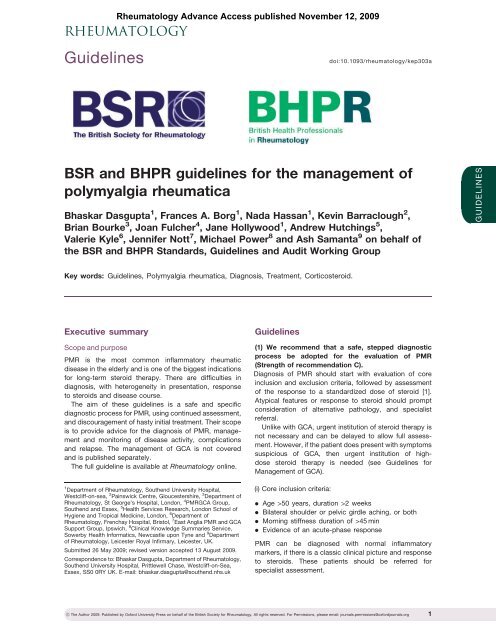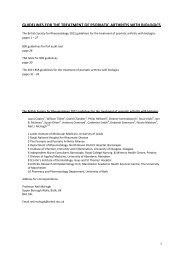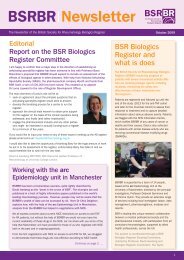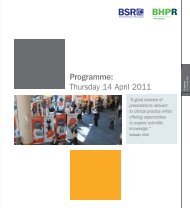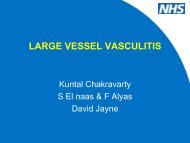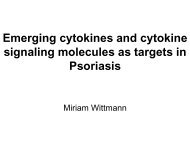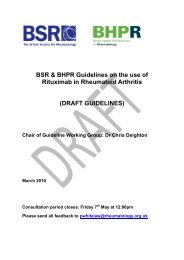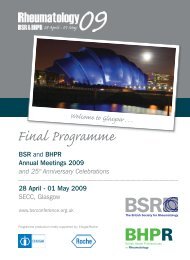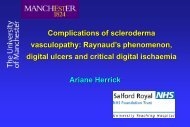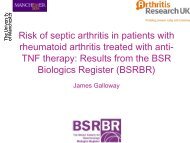Management of polymyalgia rheumatica - The British Society for ...
Management of polymyalgia rheumatica - The British Society for ...
Management of polymyalgia rheumatica - The British Society for ...
You also want an ePaper? Increase the reach of your titles
YUMPU automatically turns print PDFs into web optimized ePapers that Google loves.
Guidelines<br />
Rheumatology Advance Access published November 12, 2009<br />
RHEUMATOLOGY<br />
doi:10.1093/rheumatology/kep303a<br />
BSR and BHPR guidelines <strong>for</strong> the management <strong>of</strong><br />
<strong>polymyalgia</strong> <strong>rheumatica</strong><br />
Bhaskar Dasgupta 1 , Frances A. Borg 1 , Nada Hassan 1 , Kevin Barraclough 2 ,<br />
Brian Bourke 3 , Joan Fulcher 4 , Jane Hollywood 1 , Andrew Hutchings 5 ,<br />
Valerie Kyle 6 , Jennifer Nott 7 , Michael Power 8 and Ash Samanta 9 on behalf <strong>of</strong><br />
the BSR and BHPR Standards, Guidelines and Audit Working Group<br />
GUIDELINES<br />
Key words: Guidelines, Polymyalgia <strong>rheumatica</strong>, Diagnosis, Treatment, Corticosteroid.<br />
Executive summary<br />
Scope and purpose<br />
PMR is the most common inflammatory rheumatic<br />
disease in the elderly and is one <strong>of</strong> the biggest indications<br />
<strong>for</strong> long-term steroid therapy. <strong>The</strong>re are difficulties in<br />
diagnosis, with heterogeneity in presentation, response<br />
to steroids and disease course.<br />
<strong>The</strong> aim <strong>of</strong> these guidelines is a safe and specific<br />
diagnostic process <strong>for</strong> PMR, using continued assessment,<br />
and discouragement <strong>of</strong> hasty initial treatment. <strong>The</strong>ir scope<br />
is to provide advice <strong>for</strong> the diagnosis <strong>of</strong> PMR, management<br />
and monitoring <strong>of</strong> disease activity, complications<br />
and relapse. <strong>The</strong> management <strong>of</strong> GCA is not covered<br />
and is published separately.<br />
<strong>The</strong> full guideline is available at Rheumatology online.<br />
1 Department <strong>of</strong> Rheumatology, Southend University Hospital,<br />
Westcliff-on-sea, 2 Painswick Centre, Gloucestershire, 3 Department <strong>of</strong><br />
Rheumatology, St George’s Hospital, London, 4 PMRGCA Group,<br />
Southend and Essex, 5 Health Services Research, London School <strong>of</strong><br />
Hygiene and Tropical Medicine, London, 6 Department <strong>of</strong><br />
Rheumatology, Frenchay Hospital, Bristol, 7 East Anglia PMR and GCA<br />
Support Group, Ipswich, 8 Clinical Knowledge Summaries Service,<br />
Sowerby Health In<strong>for</strong>matics, Newcastle upon Tyne and 9 Department<br />
<strong>of</strong> Rheumatology, Leicester Royal Infirmary, Leicester, UK.<br />
Submitted 26 May 2009; revised version accepted 13 August 2009.<br />
Correspondence to: Bhaskar Dasgupta, Department <strong>of</strong> Rheumatology,<br />
Southend University Hospital, Prittlewell Chase, Westcliff-on-Sea,<br />
Essex, SS0 0RY UK. E-mail: bhaskar.dasgupta@southend.nhs.uk<br />
Guidelines<br />
(1) We recommend that a safe, stepped diagnostic<br />
process be adopted <strong>for</strong> the evaluation <strong>of</strong> PMR<br />
(Strength <strong>of</strong> recommendation C).<br />
Diagnosis <strong>of</strong> PMR should start with evaluation <strong>of</strong> core<br />
inclusion and exclusion criteria, followed by assessment<br />
<strong>of</strong> the response to a standardized dose <strong>of</strong> steroid [1].<br />
Atypical features or response to steroid should prompt<br />
consideration <strong>of</strong> alternative pathology, and specialist<br />
referral.<br />
Unlike with GCA, urgent institution <strong>of</strong> steroid therapy is<br />
not necessary and can be delayed to allow full assessment.<br />
However, if the patient does present with symptoms<br />
suspicious <strong>of</strong> GCA, then urgent institution <strong>of</strong> highdose<br />
steroid therapy is needed (see Guidelines <strong>for</strong><br />
<strong>Management</strong> <strong>of</strong> GCA).<br />
(i) Core inclusion criteria:<br />
. Age >50 years, duration >2 weeks<br />
. Bilateral shoulder or pelvic girdle aching, or both<br />
. Morning stiffness duration <strong>of</strong> >45 min<br />
. Evidence <strong>of</strong> an acute-phase response<br />
PMR can be diagnosed with normal inflammatory<br />
markers, if there is a classic clinical picture and response<br />
to steroids. <strong>The</strong>se patients should be referred <strong>for</strong><br />
specialist assessment.<br />
! <strong>The</strong> Author 2009. Published by Ox<strong>for</strong>d University Press on behalf <strong>of</strong> the <strong>British</strong> <strong>Society</strong> <strong>for</strong> Rheumatology. All rights reserved. For Permissions, please email: journals.permissions@ox<strong>for</strong>djournals.org 1
Bhaskar Dasgupta et al.<br />
(ii) Core exclusion criteria:<br />
. Active infection<br />
. Active cancer<br />
. Active GCA (see part iii)<br />
<strong>The</strong> presence <strong>of</strong> the following conditions decreases<br />
the probability <strong>of</strong> PMR, and they should also be<br />
excluded:<br />
. Other inflammatory rheumatic diseases<br />
. Drug-induced myalgia<br />
. Chronic pain syndromes<br />
. Endocrine disease<br />
. Neurological conditions, e.g. Parkinsons disease<br />
(iii) Patients should be assessed <strong>for</strong> evidence <strong>of</strong> GCA,<br />
as this requires urgent institution <strong>of</strong> high-dose steroid<br />
(see separate guidelines)<br />
. Abrupt-onset headache (usually temporal) and<br />
temporal tenderness<br />
. Visual disturbance, including diplopia<br />
. Jaw or tongue claudication<br />
. Prominence, beading or diminished pulse on examination<br />
<strong>of</strong> the temporal artery<br />
. Upper cranial nerve palsies<br />
. Limb claudication or other evidence <strong>of</strong> large-vessel<br />
involvement<br />
(iv) Patients should be assessed <strong>for</strong> response to an initial<br />
standardized dose <strong>of</strong> prednisolone 15 mg daily orally<br />
[1, 2].<br />
A patient-reported global improvement <strong>of</strong> 570% within<br />
a week <strong>of</strong> commencing steroids is consistent with PMR,<br />
with normalization <strong>of</strong> inflammatory markers in 4 weeks.<br />
A lesser response should prompt the search <strong>for</strong> an alternative<br />
condition.<br />
(v) <strong>The</strong> diagnosis <strong>of</strong> PMR should be confirmed on further<br />
follow-up [2]. Follow-up visits should include vigilance<br />
<strong>for</strong> mimicking conditions.<br />
(2) We recommend documentation in the patient’s<br />
medical record <strong>of</strong> a minimum data set, which <strong>for</strong>ms<br />
the basis <strong>for</strong> the diagnosis.<br />
. <strong>The</strong> core clinical inclusion and any exclusion criteria<br />
. Laboratory investigations be<strong>for</strong>e commencement <strong>of</strong><br />
steroid therapy<br />
Full blood count<br />
ESR/plasma viscosity and/or CRP<br />
Urea and electrolytes<br />
Liver function tests<br />
Bone pr<strong>of</strong>ile<br />
Protein electrophoresis (also consider urinary<br />
Bence Jones Protein)<br />
Thyroid stimulating hormone<br />
Creatine kinase<br />
RF (ANA and anti-CCP antibodies may be<br />
considered)<br />
Dipstick urinalysis<br />
Chest X-ray may be required<br />
(3) We recommend the following approach <strong>for</strong> the<br />
evaluation <strong>of</strong> proximal pain and stiffness [3] (Fig. 1).<br />
(4) We recommend early specialist referral in the<br />
following circumstances (C).<br />
Atypical features or features that increase likelihood <strong>of</strong><br />
a non-PMR diagnosis:<br />
. Age 2 months)<br />
. Lack <strong>of</strong> shoulder involvement<br />
. Lack <strong>of</strong> inflammatory stiffness<br />
. Prominent systemic features, weight loss, night pain,<br />
neurological signs<br />
. Features <strong>of</strong> other rheumatic disease<br />
. Normal or extremely high acute-phase response<br />
Treatment dilemmas such as:<br />
. Incomplete, poorly sustained or non-response to<br />
corticosteroids<br />
. Inability to reduce corticosteroids<br />
. Contraindications to corticosteroid therapy<br />
. <strong>The</strong> need <strong>for</strong> prolonged corticosteroid therapy<br />
(>2 years)<br />
However, patients with a typical clinical picture and<br />
complete sustained response to treatment, and no<br />
adverse events can be managed in primary care.<br />
(5) We recommend initiation <strong>of</strong> low-dose steroid<br />
therapy with gradually tailored tapering in straight<strong>for</strong>ward<br />
PMR (B).<br />
In the absence <strong>of</strong> GCA, urgent steroid therapy is not<br />
indicated be<strong>for</strong>e the clinical evaluation is complete.<br />
<strong>The</strong> suggested regimen is:<br />
. Daily prednisolone 15 mg <strong>for</strong> 3 weeks<br />
. <strong>The</strong>n 12.5 mg <strong>for</strong> 3 weeks<br />
. <strong>The</strong>n 10 mg <strong>for</strong> 4–6 weeks<br />
. <strong>The</strong>n reduction by 1 mg every 4–8 weeks or alternate<br />
day reductions (e.g. 10/7.5 mg alternate days, etc.)<br />
However, there is no consistent evidence <strong>for</strong> an ideal<br />
steroid regimen suitable <strong>for</strong> all patients. <strong>The</strong>re<strong>for</strong>e, the<br />
approach to treatment must be flexible and tailored to<br />
the individual as there is heterogeneity in disease<br />
course. Some benefit from a more gradual steroid<br />
taper. Dose adjustment may be required <strong>for</strong> disease<br />
severity, comorbidity, side effects and patient wishes.<br />
Intramuscular methylprednisolone (i.m. depomedrone)<br />
may be used in milder cases and may reduce the risk <strong>of</strong><br />
steroid-related complications. Initial dose is 120 mg every<br />
3–4 weeks, reducing by 20 mg every 2–3 months [4].<br />
Usually 1–2 years <strong>of</strong> treatment is needed [5]. <strong>The</strong> need<br />
<strong>for</strong> ongoing therapy after 2 years <strong>of</strong> treatment should<br />
2 www.rheumatology.ox<strong>for</strong>djournals.org
Guidelines <strong>for</strong> the management <strong>of</strong> PMR<br />
FIG. 1 Approach to the evaluation <strong>of</strong> proximal pain and stiffness. ACJ: acromio-clavicular joint.<br />
Presenting complaint<br />
Articular/periarticular/<br />
non-articular<br />
Clinical features<br />
Age >50 years,<br />
predominant shoulder<br />
and thigh symptoms<br />
symmetrical<br />
Diagnosis<br />
PMR<br />
Inflammatory<br />
Morning stiffness<br />
Joint swelling<br />
Predominant peripheral<br />
joint symptoms, X-rays<br />
Peripheral hand/foot<br />
oedema<br />
RA, other inflammatory<br />
arthritis<br />
RS3PE syndrome<br />
Multisystem disease<br />
autoantibodies<br />
SLE<br />
Vasculitis<br />
Other CTDs<br />
Proximal<br />
pain<br />
or<br />
stiffness<br />
Articular<br />
Weakness <strong>of</strong> muscles,<br />
high creatine kinase<br />
Shoulder, ACJ, cervical<br />
spine, hips, X-rays,<br />
Inflammatory myopathy<br />
OA<br />
Septic arthritis<br />
Periarticular<br />
Capsular restriction, etc.<br />
Ultrasonography<br />
Elevated<br />
ESR/CRP, relevant<br />
history and tests<br />
e.g. urinalysis<br />
Adhesivecapsulitis<br />
Rotator cuff lesions<br />
Concomitant sepsis,<br />
e.g. urinary infection<br />
Noninflammatory/<br />
infective/<br />
neoplastic/<br />
neuro/endocrine<br />
Non-articular<br />
Microscopic haematuria,<br />
fever, murmur<br />
Weight loss, associated<br />
features<br />
Tender spots, longstanding<br />
history<br />
Thyroid Stimulating<br />
Hormone (TSH),<br />
bone pr<strong>of</strong>ile, (PTH,<br />
Vitamin D)<br />
Rigidity, shuffle, stare,<br />
gradual onset<br />
Occult and deep sepsis,<br />
e.g. spine, hip<br />
bacterial endocarditis<br />
Neoplasia, e.g. myeloma<br />
Fibromyalgia, chronic<br />
pain syndromes,<br />
Depression<br />
Endocrinopathy, metabolic<br />
bone disease<br />
Parkinsonism<br />
prompt the consideration <strong>of</strong> an alternative diagnosis,<br />
and referral <strong>for</strong> specialist evaluation.<br />
(6) We recommend the use <strong>of</strong> bone protection<br />
when initiating steroids <strong>for</strong> PMR to prevent the<br />
complications <strong>of</strong> osteoporosis (A ).<br />
. Individuals with high fracture risk, e.g. aged 565 years<br />
or prior fragility fracture<br />
Bisphosphonate with calcium and vitamin D<br />
supplementation<br />
DEXA not required<br />
. Other individuals<br />
Calcium and vitamin D supplementation when<br />
starting steroid therapy.<br />
DEXA scan recommended<br />
A bone-sparing agent may be indicated if T-score<br />
is 1.5 or lower.<br />
. Individuals requiring higher initial steroid dose<br />
Bisphosphonate with calcium and vitamin D<br />
supplementation (because higher cumulative<br />
steroid dose is likely)<br />
www.rheumatology.ox<strong>for</strong>djournals.org 3
Bhaskar Dasgupta et al.<br />
FIG. 2 Approach to diagnosis and management <strong>of</strong> <strong>polymyalgia</strong>.<br />
Step 1<br />
Inclusion<br />
Bilateral shoulder and/or pelvic girdle pain<br />
Morning stiffness >45 min<br />
Abrupt onset<br />
Age >50 years<br />
Duration >2 weeks<br />
Acute-phase response (raised ESR/CRP)<br />
Step 2<br />
Exclusion<br />
Lab tests prior to steroids:<br />
Full blood count<br />
ESR<br />
CRP<br />
Plasma viscosity<br />
Urea and Electrolytes<br />
Liver function tests<br />
Calcium, alkaline phosphatase<br />
Protein electrophoresis /<br />
Bence Jones protein<br />
Thyroid stimulating hormone<br />
Creatine kinase<br />
RF<br />
ANA<br />
Chest X-ray (e.g. in cases<br />
with prominent systemic<br />
symptoms)<br />
Dipstick urinalysis<br />
Active cancer<br />
Infection<br />
Active GCA (see BSR Guidelines <strong>for</strong><br />
GCA)<br />
Inflammatory:<br />
RA other arthropathies<br />
SLE, myopathies, other CTDs<br />
Non-inflammatory:<br />
Local shoulder and hip conditions<br />
Fibromyalgia/pain syndromes<br />
Step 3<br />
Low-dose steroids<br />
Early specialist referral is recommended <strong>for</strong>:<br />
Patients with atypical features or features that<br />
increase likelihood <strong>of</strong> a non-PMR diagnosis:<br />
• Younger patient < 60 years<br />
• Chronic onset<br />
• Lack <strong>of</strong> shoulder involvement<br />
• Lack <strong>of</strong> inflammatory stiffness<br />
• ‘Red flag’ features: prominent systemic<br />
features, weight loss, night pain,<br />
neurological signs<br />
• Peripheral arthritis or other features <strong>of</strong><br />
CTD/ muscle disease<br />
• Normal or very high ESR/CRP<br />
or treatment dilemmas such as:<br />
• Incomplete or non-response to<br />
corticosteroids<br />
Step 4<br />
Follow-up (4–6 weeks)<br />
Prednisolone 15–20 mg daily<br />
Clinical response in 1 week<br />
At least 70% global<br />
improvement<br />
Lab. resolution in 3–4<br />
Symptoms to monitor<br />
Proximal pain<br />
Morning stiffness<br />
Disability related to the PMR<br />
Adverse events<br />
Osteoporotic risk<br />
Symptoms that may suggest an<br />
alternative diagnosis<br />
No alternative<br />
diagnoses<br />
PMR<br />
Gradual steroid tapering<br />
i.m. depomedrone in mild<br />
cases, contraindications<br />
Bone protection<br />
Lab. monitoring<br />
every 3 months<br />
Full blood count<br />
ESR/CRP<br />
Urea electrolytes<br />
Glucose<br />
Relapses:<br />
Increase steroids to previous higher dosage first and second<br />
relapse<br />
Consider immunosuppressive, e.g. MTX<br />
GCA relapse: treat with high-dose steroids 40–60 mg<br />
prednisolone<br />
(7) We recommend vigilant monitoring <strong>of</strong> patients <strong>for</strong><br />
response to treatment and disease activity (B).<br />
Follow-up schedule:<br />
Weeks 0, 1–3, 6, Months 3, 6, 9, 12 in first year (with<br />
extra visits <strong>for</strong> relapses or adverse events).<br />
Early follow-up is necessary as part <strong>of</strong> the diagnosis<br />
to evaluate response to initial therapy [2], and the first<br />
follow-up should occur at 1–3 weeks be<strong>for</strong>e commencement<br />
<strong>of</strong> steroids.<br />
Clinical assessment:<br />
At each visit, patients should be assessed <strong>for</strong> the<br />
following:<br />
. Response to treatment: proximal pain, fatigue and<br />
morning stiffness<br />
4 www.rheumatology.ox<strong>for</strong>djournals.org
Guidelines <strong>for</strong> the management <strong>of</strong> PMR<br />
It is important to distinguish between symptoms due to<br />
inflammation and those due to co-existing degenerative<br />
problems.<br />
. Complications <strong>of</strong> disease including symptoms <strong>of</strong> GCA,<br />
e.g. headaches, jaw claudication and large-vessel<br />
disease<br />
. Steroid-related adverse events<br />
. Atypical features or those suggesting an alternative<br />
diagnosis<br />
Laboratory monitoring:<br />
. Full blood count, ESR/CRP, urea and electrolytes,<br />
glucose<br />
Duration <strong>of</strong> treatment and follow-up:<br />
. Usually 1–3 years <strong>of</strong> treatment, although some will<br />
require small doses <strong>of</strong> steroids beyond this.<br />
Flexibility in approach is necessary given the heterogeneous<br />
nature <strong>of</strong> disease. Steroids may be stopped<br />
when the patient is asymptomatic from their inflammatory<br />
symptoms.<br />
. Isolated raised ESR or CRP is not an indication <strong>for</strong><br />
continuing steroid therapy but may require investigation<br />
and referral.<br />
. Persistent pain may arise from co-existing OA and<br />
rotator cuff tears.<br />
(8) We recommend the following approach to relapse<br />
<strong>of</strong> disease.<br />
Relapse is the recurrence <strong>of</strong> symptoms <strong>of</strong> PMR or onset<br />
<strong>of</strong> GCA, and not just unexplained raised ESR or CRP [6].<br />
Treatment <strong>of</strong> relapse:<br />
. Clinical features <strong>of</strong> GCA: treat as GCA (usually oral<br />
prednisolone 40–60 mg daily) (see GCA guideline)<br />
. Clinical features <strong>of</strong> PMR: increase prednisolone to<br />
previous higher dose.<br />
. Single i.m. injection <strong>of</strong> methylprednisolone (depomedrone)<br />
120 mg can also be used.<br />
. Further relapses: consider introducing DMARD therapy<br />
after two relapses<br />
<strong>The</strong> approach to diagnosis and management <strong>of</strong> PMR<br />
is summarized in Fig. 2.<br />
Patient education<br />
An ARC patient in<strong>for</strong>mation booklet is available. Further<br />
support is available from local patient groups under the<br />
auspices <strong>of</strong> PMRGCA-UK.<br />
Recommendations <strong>for</strong> audit<br />
Audit standards should include the minimum data set<br />
recorded prior to steroid therapy, initial steroid dose and<br />
taper, monitoring schedule, use <strong>of</strong> bone protection and<br />
provision <strong>of</strong> patient in<strong>for</strong>mation.<br />
Outcomes measures include disease relapse, persistent<br />
disease activity, cumulative steroid dosage, adverse<br />
events and complications <strong>of</strong> therapy and quality <strong>of</strong> life.<br />
Disclosure statement: <strong>The</strong> authors have declared no<br />
conflicts <strong>of</strong> interest.<br />
References<br />
1 Dasgupta B, Salvaran IC, Schirmer M, Crowson CS,<br />
Maradit-Kremers H, Matteson EL. and Members <strong>of</strong> the<br />
American College <strong>of</strong> Rheumatology Work Group <strong>for</strong><br />
Development <strong>of</strong> Classification Criteria <strong>for</strong> PMR.<br />
Development <strong>of</strong> classification criteria <strong>for</strong> <strong>polymyalgia</strong><br />
<strong>rheumatica</strong> (PMR): results from an expert work group<br />
meeting and a wider survey. J Rheumatol 2008;35:270–7.<br />
2 Hutchings A, Hollywood J, Lamping D et al. Clinical<br />
outcomes, quality <strong>of</strong> life and diagnostic uncertainty in<br />
the first year in <strong>polymyalgia</strong> <strong>rheumatica</strong>. Arthritis Rheum<br />
2007;57:803–9.<br />
3 Brooks RC, McGee SR. Diagnostic dilemmas in<br />
<strong>polymyalgia</strong> <strong>rheumatica</strong>. Arch Int Med 1997;157:162–8.<br />
4 Dasgupta B, Dolan AL, Fernandes L, Panayi G. An<br />
initially double-blind controlled 96 week trial <strong>of</strong> depot<br />
methylprednisolone against oral prednisolone in the<br />
treatment <strong>of</strong> <strong>polymyalgia</strong> <strong>rheumatica</strong>. Brit J Rheumatol<br />
1998;37:189–95.<br />
5 Kyle V, Hazleman BL. Treatment <strong>of</strong> <strong>polymyalgia</strong> rheumatic<br />
and giant cell arteritis. II. Relation between steroid dosing<br />
and steroid associated side effects. Ann Rheum Dis 1989;<br />
48:662–6.<br />
6 Maradit Kremers H, Reinalda MS, Crowson CS,<br />
Zinsmeister AR, Hunder GG, S Gabriel. Relapse in a<br />
population based cohort <strong>of</strong> patients with PMR.<br />
J Rheumatol 2005;32:65–73.<br />
www.rheumatology.ox<strong>for</strong>djournals.org 5


